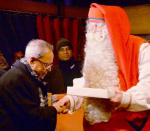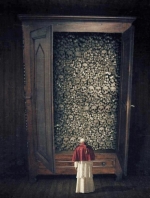 My own wish would be to reclaim Kolkata from Teresa—to sever the automatic connection of the two names as the whole wide world sees it. Kolkata’s image under the yoke of Mother Teresa will take a century to recover. In the last 50 years, the city has lost an unimaginable amount from the loss of international business and tourism and will continue to do so. But let us at least loudly, proudly proclaim that we have nothing to do with a medieval creature of darkness—not any more. – Dr Aroup Chatterjee
My own wish would be to reclaim Kolkata from Teresa—to sever the automatic connection of the two names as the whole wide world sees it. Kolkata’s image under the yoke of Mother Teresa will take a century to recover. In the last 50 years, the city has lost an unimaginable amount from the loss of international business and tourism and will continue to do so. But let us at least loudly, proudly proclaim that we have nothing to do with a medieval creature of darkness—not any more. – Dr Aroup Chatterjee
If Mother Teresa, to be canonised at the Vatican on September 4, is to be named a patron saint of anything it should be for “misinformation”. In the last 20 years of her life, truth became an unknown entity to her. The media aided and abetted her lack of integrity and in a way she cannot be blamed for believing in her own lies.
Intellect was not her strong point and, for someone like her, to be surrounded by hordes of sycophants who were telling her if she said black was white then that had to be true, it became intoxicating. The media did spread the mega-myth about her, but she herself was the source. She repeatedly told the world she went around the city 24×7 “picking up” destitute from its squalid “gutters” (she did not), that she fed up to 9,000 in her soup kitchens (she did not), she never refused a helpless child (she did as a rule), that the dying destitute in her so-called home for the dying Nirmal Hriday died a “beautiful death” (they were treated harshly and often died a miserable, painful death).
Mother Teresa was an ultimate politician who worked on behalf of the Vatican. No, she was not an “agent” as that would be conspiratorial. She did not have to do much subterfuge or skulduggery in India itself, as Indians, particularly the media, were in awe of her and connived with her.
When she said in her Nobel speech that she created 61,237 fewer children from (slum) couples abstaining from sex, no one challenged her on her bogus and fantastic figure; neither did they ask her how at the height of the Cold War abortion could be the “greatest destroyer of peace” (said a thousand times, including in her Nobel speech).
I do not blame world media as much as I blame Indian and particularly Kolkata media. Here she was, a jet-setting celebrity—although appended with the epithet “of Calcutta”—spending six to nine months in a year in Europe and the US, making strange claims about her work and about the disgusting state of the city, but never to be seen in the city’s disasters—major or minor.
Why was she not asked why she re-used needles on her residents in Nirmal Hriday (it was official policy) when she herself received the finest care in the world’s best hospitals?
Even after her death, the Indian fear of blue-bordered saris continues. On August 1, 2005, UK TV showed a child tied to a cot overnight in her orphanage—one Kolkata newspaper grudgingly reported the matter with lots of “alleged”. During her lifetime, even that would be unthinkable. She was white, she hobnobbed with President Ronald Reagan (they were closest of buddies), and oh yes, she had the Nobel—so she had to be divine.
 Did no one know that she hobnobbed with the Duvaliers of Haiti whose brutality was unsurpassed (whose opponents were often cut up and fed to dogs)? No one in India wanted to know. For the Western media, she was a metaphor, a set-piece, a stratospheric certainty of image in an uncertain and changing world. Conversely, Kolkata was the opposite metaphor of absolute degradation where “foetuses are given to dogs to eat” (as remarked by her “other self” Francis Goree).
Did no one know that she hobnobbed with the Duvaliers of Haiti whose brutality was unsurpassed (whose opponents were often cut up and fed to dogs)? No one in India wanted to know. For the Western media, she was a metaphor, a set-piece, a stratospheric certainty of image in an uncertain and changing world. Conversely, Kolkata was the opposite metaphor of absolute degradation where “foetuses are given to dogs to eat” (as remarked by her “other self” Francis Goree).
It was beyond the West’s interest, energy or remit to robustly challenge these wrong stereotypes. But did Indian journalists not know that her main bank was the Vatican Bank, a dark cavern of corruption, intrigue and murder? Before she died, it was well known that she had accepted millions from Charles Keating, the notorious American swindler, but no one in India cared.
 Bengalis showed some rare guts when she was beatified through a “miracle” in 2003. Doctors, and even the then Health Minister, made statements that Monica Besra was cured by prolonged treatment, and not by an aluminium medal. Even Besra herself periodically said her cure was not a miracle. But the Vatican treated Indian opinion with the contempt it always has and proceeded with canonisation.
Bengalis showed some rare guts when she was beatified through a “miracle” in 2003. Doctors, and even the then Health Minister, made statements that Monica Besra was cured by prolonged treatment, and not by an aluminium medal. Even Besra herself periodically said her cure was not a miracle. But the Vatican treated Indian opinion with the contempt it always has and proceeded with canonisation.
But what is so great about Catholic saints? People should realise a Catholic saint does not have to be saintly or nice in the secular sense, but has to be pure to Catholic dogma, especially on contraception and abortion. Jose Maria Escriva, a Fascist, is a Catholic saint; another Fascist, Cardinal Stepinac, is a “blessed”. “Saint” John Paul II actively shielded the prolific paedophile and criminal Marcial Maciel over many years. Mother Teresa also wrote a letter of support for a convicted priest Donald McGuire, asking people to overlook his “imprudence”.
If one looks around Mother Teresa’s homes in Kolkata today, one would find many of them acceptable. But one must not forget that this comes after 25 years of campaigning by me, and also persistent global criticism from Hemley Gonzalez, the American former volunteer who in 2008 was so utterly disgusted by what he saw that he founded the Stop the Missionaries of Charity movement and founded his own Responsible Charity. Moreover, in the last six months the order has spruced up a great deal, preparing for the canonisation on Sunday.
And yet, like obliging picaninnies, the Indian government is dutifully sending a delegation to the black-magic ceremony in Rome. (Hindus please note: the Pope is not allowed to wish Hindus personally even on Diwali.)
Be that as it may, my own wish would be to reclaim Kolkata/Calcutta from Teresa—to sever the automatic connection of the two names as the whole wide world sees it. Kolkata’s image under the yoke of Mother Teresa will take a century to recover. In the last 50 years, the city has lost an unimaginable amount from the loss of international business and tourism and will continue to do so. But let us at least loudly, proudly proclaim that we have nothing to do with a medieval creature of darkness—not any more. – The Economic Times, 3 September 2016
» Dr Aroup Chatterjee was born and brought up in Calcutta. He now lives and works as a physician in London. He was, if anything, positively inclined towards Mother Teresa while he was living in Calcutta, though he knew little about her. Upon coming to the West he was appalled at the Teresan mythology and at the gruesome image that his home city had in the world. He has done research on Mother Teresa for over twenty-five years and can be called the world’s foremost authority on the late nun. He is the author of the famous book Mother Teresa—The Untold Story.
Filed under: india | Tagged: aroup chatterjee, catholic church, conversion, india, missionaries of charity, mother teresa, mother teresa, religious conversion, roman catholic church, sadism, sainthood |





























By sending the official delegation to the Vatican for the canonization of MT, the BJP sarkar thinks they can corner some Christian votes too, but little do they realize that not only would the not get those sought-for Christian votes but they would lose the Hindu votes. The votes that got them an unassailable majority the last time around. It’s called being too clever for one’s own good.
LikeLike
Mother Teresa – Justice Katju – Facebook – 5 Sept 2016
I cannot understand all the fanfare and brouhaha about ‘Mother’ Teresa. In my opinion she was a reactionary semi educated fundamentalist, fanatic and fraud.
In her Nobel Prize acceptance speech she asserted before a dumb founded audience that ‘ abortion was the greatest destroyer of world peace ‘. One’s mind boggles to understand the connection between abortion and world peace.
To some American Professors who came to visit her she said ” We have a home for the dying in Calcutta, where we have picked up more than 36,000 people only from the streets of Calcutta, and out of that big number more than 18,000 have died a beautiful death. They have just gone home to God “. How hungry, homeless people have a ‘beautiful’ death passes all comprehension.
As for the “miracle” that had to be attested for declaring her a saint, one cringes with shame at the obviousness of the fakery. A Bengali woman named Monica Besra claimed that a beam of light emerged from a picture of MT, which she happened to have in her home, and relieved her of a cancerous tumor. Her physician, Dr. Ranjan Mustafi, said that she didn’t have a cancerous tumor in the first place and that the tubercular cyst she did have was cured by a course of prescription medicine. Was he interviewed by the Vatican’s investigators? No. The same can be said about her other ‘miracles’.
She said that poverty and suffering was a gift from God, when the truth is that poverty is the worst thing in life.
And she was a friend to the worst of the rich, taking misappropriated money from the atrocious Duvalier family in Haiti (whose rule she praised in return) and from Charles Keating of the Lincoln Savings and Loan. Where did that money, and all the other donations, go? The primitive hospice in Calcutta was as run down when she died as it always had been—she preferred California clinics when she got sick herself—and her order always refused to publish any audit. But we have her own claim that she opened 500 convents in more than a hundred countries, all bearing the name of her own order. Is this modesty and humility?
The rich of the world have a poor conscience, and many rich people like to alleviate their own unease by sending money to a woman who seemed like an activist for “the poorest of the poor.” People do not like to admit that they have been gulled or conned, so a vested interest in the myth was permitted to arise, and a lazy media never bothered to ask any follow-up questions. Many volunteers who went to Calcutta came back abruptly disillusioned by the reactionary, fundamentalist ideology and poverty-loving practice of the “Missionaries of Charity,”
Aroup Chatterjee, a doctor, grew up in Kolkata and now works in the UK. He is one of Mother Teresa’s most vocal critics. “Many rogues have become Catholic saints,” he said. “What bothers me is that the world makes such a song and dance about a superstitious, black magic ceremony.”
He added: “It’s obvious that people are duped, they have a herd mentality. But the media has a responsibility not to collude with it.”
He has described Mother Teresa as “a medieval creature of darkness” and a “bogus and fantastic figure” who went unchallenged by the world’s media.
According to his 2003 book, Mother Teresa: The Final Verdict, based on the testimonies of scores of people who worked with the Missionaries of Charity, the medical care given to sick and dying people was negligible. Syringes were reused without sterilisation, pain relief was non-existent or inadequate, and conditions were unhygienic. Meanwhile, Mother Teresa spent much of her time travelling around the world in a private plane to meet political leaders.
Similar criticisms were made by the late writer Christopher Hitchens in his book, The Missionary Position. Mother Teresa was, he wrote, a “religious fundamentalist, a political operative, a primitive sermoniser, and an accomplice of worldly secular powers”.
The focus of the nun’s work, he said, was “not the honest relief of suffering but the promulgation of a cult based on death and suffering and subjection”.
Among those cited by Hitchens was Susan Shields, a former worker with the Missionaries of Charity, who claimed that vast sums of money accrued in bank accounts but very little was spent on medical expertise or making the lives of the sick and dying more comfortable.
Robin Fox, the editor of the Lancet, wrote in 1994 about the “haphazard” approach to care by nuns and volunteers, and the lack of medically trained personnel in the order’
The investigative journalist Donal Macintyre spent a week working undercover in a Missionaries of Charity home for disabled children in Kolkata in 2005. In an article in the New Statesman, he described pitiful scenes. “For the most part, the care the children received was inept, unprofessional and, in some cases, rough and dangerous.”
Three years ago, a study by academics at the University of Montreal concluded that the Vatican had ignored Mother Teresa’s “rather dubious way of caring for the sick, her questionable political contacts, her suspicious management of the enormous sums of money she received, and her overly dogmatic views regarding … abortion, contraception and divorce.”
But, it will be said, she did after all work among the poor and homeless. Well, I am prepared to do the same if I am given 10 million dollars.
LikeLike